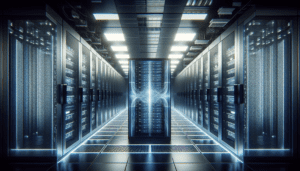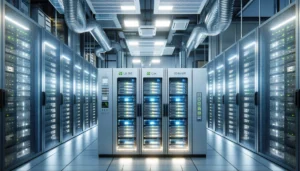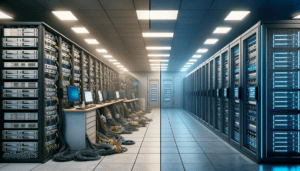Data centre costs can quickly spiral out of control, impacting your bottom line and operational efficiency. At EziBlank, we understand the importance of maximising your investment while minimising unnecessary expenditure. Our innovative air-flow management solutions, particularly our advanced blanking panels, are designed to enhance your data centre's performance and cut energy consumption significantly. By optimising your infrastructure, you are not just preserving core knowledge assets but also paving the way towards a more sustainable and cost-effective future. Take the first step towards transforming your data centre today!
Elevate Data Center Performance with Blanking Panels
Enhancing the performance of data centres often hinges on small yet impactful innovations, such as the strategic use of blanking panels. These panels are designed to cover unused spaces in server racks, preventing hot air from recirculating and ensuring that cooling systems work at peak efficiency. By improving airflow management, blanking panels help maintain optimal operating conditions for servers, reducing the risk of overheating and boosting overall system performance. For data centres striving to maximise efficiency and reliability, blanking panels offer a straightforward and effective solution.
Read More
What are blanking panels and how do they work?
Blanking panels are a critical yet often underappreciated component in the design of efficient data centres. These panels are used to cover empty spaces within server racks, preventing the unwanted mixing of hot and cold air. By directing the airflow more effectively, blanking panels ensure that cooling systems operate more efficiently, reducing the energy required to maintain optimal temperatures. This not only enhances the performance and longevity of the equipment but also contributes to significant energy savings, making blanking panels a simple but powerful tool in data centre management.
Read More
How Do I Reduce Data Center Operating Costs?
Reducing operating costs in data centres is a key priority for businesses seeking to maximise efficiency while maintaining high performance. One of the most effective strategies involves optimising cooling systems, as cooling typically accounts for a significant portion of energy expenses. Implementing solutions like blanking panels to manage airflow and prevent hot air recirculation can drastically reduce the energy needed for cooling. Additionally, adopting energy-efficient hardware and monitoring systems to track and adjust power usage can further drive down costs. By focusing on these areas, data centres can achieve substantial cost savings while maintaining optimal operational standards.
Read More
Best Practices for Data Center Scalability
Scalability is a cornerstone of modern data centre management, ensuring that facilities can grow and adapt to meet increasing demands without compromising performance. Best practices for achieving scalability include modular design, which allows for the incremental addition of capacity, and the implementation of efficient cooling solutions that can be scaled alongside the infrastructure. The use of blanking panels to manage airflow and reduce energy consumption is another key strategy, as it supports both current and future expansion needs. By focusing on these scalable solutions, data centres can remain agile and responsive to the ever-evolving technological landscape.
Read More
The Importance of Energy Efficiency in Data Centres
Energy efficiency is a crucial factor in the operation of data centres, as these facilities consume vast amounts of power to keep servers running and maintain optimal cooling conditions. Improving energy efficiency not only reduces operational costs but also lessens the environmental impact of data centres, aligning with global sustainability goals. Strategies such as implementing advanced cooling systems, utilising renewable energy sources, and optimising airflow management with tools like blanking panels are key to achieving higher energy efficiency. By focusing on these areas, data centres can enhance performance while contributing to a more sustainable future.
Read More
How much does it cost to build a data center?
The cost of building a data centre can vary widely depending on factors such as location, size, design specifications, and the level of technology incorporated. On average, constructing a small to mid-sized data centre can range from several million to tens of millions of dollars. Larger, hyperscale data centres, which are designed to support massive computing needs, can cost hundreds of millions to over a billion dollars. These costs include land acquisition, construction, electrical and cooling infrastructure, security systems, and the installation of servers and networking equipment. Additionally, ongoing operational costs such as energy, maintenance, and staffing must be factored into the total investment, making data centres a significant financial commitment for any organisation.
Read More
Everything you need to know about data center power
Power is the lifeblood of any data centre, underpinning the operation of servers, cooling systems, and networking equipment. Ensuring a reliable and continuous power supply is critical, as even a brief outage can lead to significant disruptions. Data centres typically rely on a combination of grid electricity, uninterruptible power supplies (UPS), and backup generators to maintain operations during power failures. Power distribution within the facility must be carefully managed to ensure that all equipment receives the necessary voltage and current, while also allowing for redundancy to prevent failures. Additionally, the efficiency of power usage is a key concern, with modern data centres adopting technologies like power usage effectiveness (PUE) metrics to optimise energy consumption and reduce costs. Understanding these aspects of data centre power is essential for maintaining high performance and reliability in a facility.
Read More
Is a green data center good for business?
A green data centre is not only beneficial for the environment but also offers significant advantages for businesses. By focusing on energy efficiency, renewable energy sources, and sustainable practices, green data centres help reduce operational costs through lower energy consumption and improved efficiency. This reduction in costs can translate into higher profitability over time. Additionally, operating a green data centre enhances a company’s reputation by demonstrating a commitment to sustainability, which can attract environmentally conscious customers and partners. Moreover, as regulations around carbon emissions tighten, having a green data centre can ensure compliance and reduce the risk of penalties. Overall, investing in a green data centre is a smart business decision that aligns economic performance with environmental responsibility.
Read More
